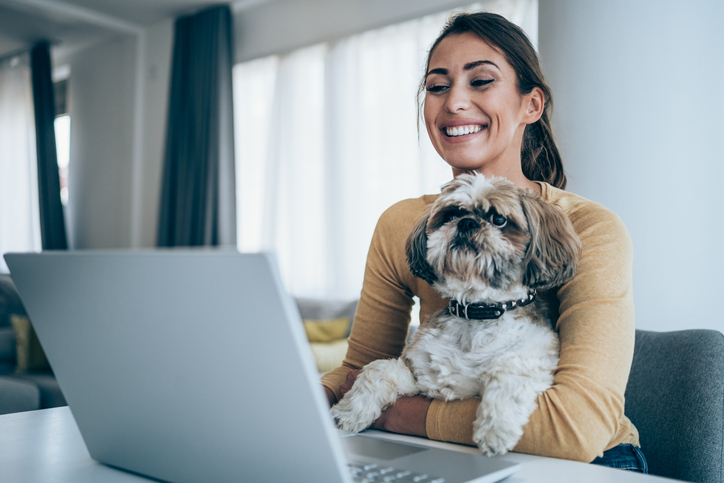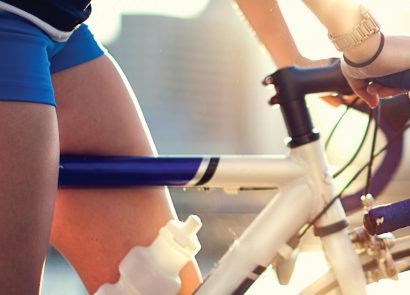Confined to our homes with limited social interaction, lockdown was undoubtedly a lonely time, so for many people, getting a pet had a huge impact on their health and happiness. According to the Pet Food Manufacturers’ Association, a whopping 3.2 million households in the UK have acquired a pet since the start of the pandemic, with dogs proving they’re still (wo)man’s best friend. And with 74 percent of people adding that their pet has had a positive effect on their mental health as they navigated Covid-19, it seems these affable pooches have cemented a place in our hearts. Here, three women share their experiences of getting a dog during lockdown and adjusting to life together post-pandemic.
“Charlie provided purpose when I needed it most”
Katy Hope and Charlie
“When lockdown happened, I went from being in an office with nearly 4,000 people to working at home alone. It was incredibly hard on my mental health and wellbeing, especially as my husband was out for nine hours a day. I had no meaningful work to do as the company I worked for put all project work on hold, so I sat at home, watched TV and ate. I went from a size 12 to 16 and could feel my mood deteriorating.
“When I met Charlie, an English springer spaniel, I knew he was the dog for me. He gave me purpose – I could not have got through last year without him. Any time that I’m feeling down or worried about something, I just put my boots on and we head outside. It’s impossible not to feel your mood improve when you see his zest for life.
“Last year, I was made redundant. I then set up my own leadership coaching and mentoring business, Katy Hope Connections, so now the biggest challenge with Charlie is time. My day starts very early and sometimes finishes quite late, and I need to fit Charlie into that routine. “Having a dog has definitely made my day longer but he’s also made it more pleasurable. It’s also helped me reconnect with my parents, I’ve made new friends and have met more people in my neighbourhood just through having a dog. They’re incredibly social creatures who help connect you with others.”
“Ruby has changed our routine”
Vee Carter and Ruby
“My children are aged nine and six, and for a few years they’ve been begging my husband and I to get a pet, namely a dog. We both work in demanding jobs, so it just didn’t seem feasible to have a dog when we weren’t at home all day. However, lockdown changed everything as we didn’t have the same excuses to bat off the kids with!
“That’s when we got Ruby, a schnoodle, which is schnauzer and miniature poodle mix. She has a lot of energy, and is happiest playing with adults and other dogs. She has a very sweet nature and is always excited to see everyone.
“Ruby has changed our routine. Since restrictions lifted, we now walk to school to ensure she’s walked, despite the kids’ protests! Both mine and my husband’s jobs can currently be fulfilled at home, but as things are starting to change and we’re both required back in the office on a hybrid basis, we’ll now try to balance our days so that one of us is always at home. There are many dog walkers locally, so we can call on them should we both be out the same day, or ask family, as Ruby has also worked her magic on them.
“As cheesy as it sounds, she has completed our family. We would be lonely without her and always dote on her!”
“I’ve gained a whole lot of love”
Kimberley Douglas and Zadie
“I grew up in a pet-filled family and have always known I’d get a dog of my own, but it’s been drummed into me by my mother that it’s not fair on a dog if you work long hours, which I do. My company decided during the first lockdown that when we were allowed back, we would adopt a hybrid approach, working a maximum of three days in the office. When Boris announced in September 2020 that it would be at least another six months of working from home, I knew that was my opportunity.
“I brought Zadie home late November. I took a week off work when she first arrived to settle her in – call it ‘pawternity leave’, if you will – and I don’t know how I would have coped otherwise.
“Since lockdown lifted, we have a new routine and it’s working well. Mondays and Fridays start with a pre-work walk in the park, before snuggling next to me and my laptop on the sofa. She goes to daycare once a week and my parents take her overnight for the other two days I’m in the office. This comes with the added bonus of freeing up my Wednesday evenings for social life.
“It’s a cliché, but getting a dog is a huge responsibility. Every time I make plans, I have to consider whether she’ll come too or how long she’ll be left at home for. I’ve lost a bit of freedom but I’ve also gained a whole lot of love.”
RSPCA’s top tips for responsible pet owners
Make gradual changes to their routine
If the time you feed or walk your dog is going to change due to altered circumstances, then bring these changes in gradually. Doing this can prevent your dog from experiencing frustration and anxiety when their daily schedule suddenly doesn’t match what they’ve come to expect.
Increase the time they spend on their own
Your dog may not have been left alone at all during lockdown, or only for brief intervals, and they’re probably used to getting much more attention and interaction. If you’re in the process of returning to an office to work, then you need to prepare them for that. Begin to gradually decrease the amount of attention you give your dog and increase the time they spend on their own. This may include not playing with your dog every time they ask or not stroking them every time they nudge you. Don’t completely ignore your dog as this may confuse them, but give them something better to do like lay on a comfy bed or chew a tasty treat to settle with.
Ease them in gently
If you’re returning to using a dog walker, friend or family member to care for your dog while you are busy they might be very excited or even a little apprehensive having spent time with only you. It can be useful for you to remain home on the first walk or two, just in case your dog needs any extra support from you. It’s important to train and socialise your dog so that they can enjoy daily activities. Owners are responsible for keeping their dogs under control so basic training is very useful.
Get them used to alone time
You may also want to think about leaving the house without your dog to help them get used to this part of their routine; this could be going to sit in the car to read a book to begin with. If your dog shows any distress when left alone, then pause your plans and seek the support of a qualified behaviourist.



















